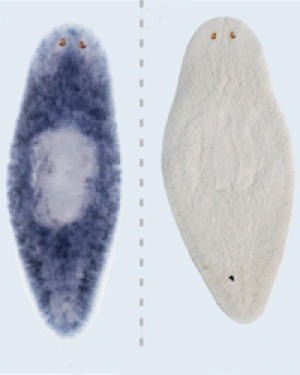导读:雷帕霉素靶蛋白存在于人类和大部分其它哺乳动物中,它所启动的信号通路在涡虫组织再生过程中起到决定性作用,失活该蛋白不仅能抑制扁形虫的再生,还能在异常组织中抑制癌细胞生长。

左图是表达TOR基因的涡虫,而右图的涡虫没有表达,这一结果来自于遗传操作。
(图片来源:美国加州大学)
加州大学的研究人员在《细胞科学》Cell Science 杂志上发表了题为“TOR Signaling Regulates Planarian Stem Cells and Controls Localized and Organismal Growth”的文章,研究表明扁形虫的细胞再生能力有助于揭示癌症如何治愈以及再生医学如何更好地靶向疾病。
生物学教授内斯托尔•奥维多发现:“雷帕霉素靶蛋白(TOR)存在于人类和大部分其它哺乳动物中,它所启动的信号通路在涡虫组织再生过程中起到决定性作用,失活该蛋白不仅能抑制扁形虫的再生,还能在异常组织中抑制癌细胞生长。”
奥维多称:“在这一新模型下,我们可以通过操纵信号通路研究干细胞的行为。”
研究人员已确认TOR蛋白在癌症、老化和退化性疾病中发挥作用,但还不清楚它如何执行功能。
为了解决这个问题,奥维多实验室把研究对象设为大家熟悉的扁形虫——涡虫。很长一段时间内涡虫一直被视为科学怪虫而没受到重视,如今,它已成为一种关键性物种以用于认识干细胞的功能。涡虫自我修复能力是不可比拟的,其中的奥秘有助于对抗癌症和退化性疾病。
在这项研究中,奥维多实验室对涡虫TOR蛋白进行失活处理,然后截去它的身体分支,在这种情况下,它不能自我修复缺损部分。
研究人员发现,涡虫干细胞能够再生组织,但常因选择错误的地方而形成畸形组织,这一种再生方式之前没人报道过。此外,涡虫在TOR蛋白失活情况下无法生长,即使能获取足够的养分。
除了抑制肿瘤外,了解Tor以及它在调控中的作用有助于开发出药物以激活组织再生和治疗退行性疾病,如阿尔茨海默氏症。
研究生Harshani Peiris是论文的第一作者,他说:“对涡虫进行研究,研究人员可看到机体的整体反应,而不是仅仅观察培养皿中的细胞。我们能够在系统水平上观察什么正在发生。”
该研究获得了加州大学癌症研究中心协调委员会UC Cancer Research Coordinating Committee资助。
论文的共同作者包括本科生Daniel Ramirez 和Devon Davidian、Marcos Garcia-Ojeda教授以及工作人员Elyze Ozamoto和Frank Weckerle。

TOR Signaling Regulates Planarian Stem Cells and Controls Localized and Organismal Growth
T. Harshani Peiris, Frank Weckerle, Elyse Ozamoto, Daniel Ramirez, Devon Davidian, Marcos E. García-Ojeda and Néstor J. Oviedo
The Target of Rapamycin (TOR) controls an evolutionarily conserved signaling pathway that modulates cellular growth and division by sensing levels of nutrients, energy and stress. As such, TOR signaling is a crucial component of tissues and organs that translates systemic signals into cellular behavior. The ubiquitous nature of TOR signaling, together with the difficulty to analyze tissue during cellular turnover and repair, have limited our understanding on how this kinase operates throughout the body. Here, we use the planarian model system to address TOR regulation at the organismal level. The planarian TOR homolog (Smed-TOR) is ubiquitously expressed, including stem cells (neoblasts) and differentiated tissues. Inhibition of TOR with RNA-interference severely restricts cell proliferation, allowing the study of neoblasts with restricted proliferative capacity during regeneration and systemic cell turnover. Strikingly, TOR signaling is required for neoblast response to amputation and localized growth (blastema). However, in the absence of TOR signaling, regeneration takes place only within differentiated tissues. In addition, TOR is essential to maintain the balance between cell division and cell death and its dysfunction leads to tissue degeneration and lack of organismal growth in the presence of nutrients. Finally, TOR function is likely mediated through TOR Complex 1 as its disruption recapitulates signs of TOR-phenotype. Our data reveal novel roles for TOR signaling in controlling adult stem cells at a systemic level and suggest a new paradigm to study TOR function during physiological turnover and regeneration.
文献链接:https://jcs.biologists.org/content/early/2012/03/16/jcs.104711.abstract








